Unit 7 TFood festival opic 2 Section D课件(共22张PPT)仁爱版八年级下册
文档属性
| 名称 | Unit 7 TFood festival opic 2 Section D课件(共22张PPT)仁爱版八年级下册 | 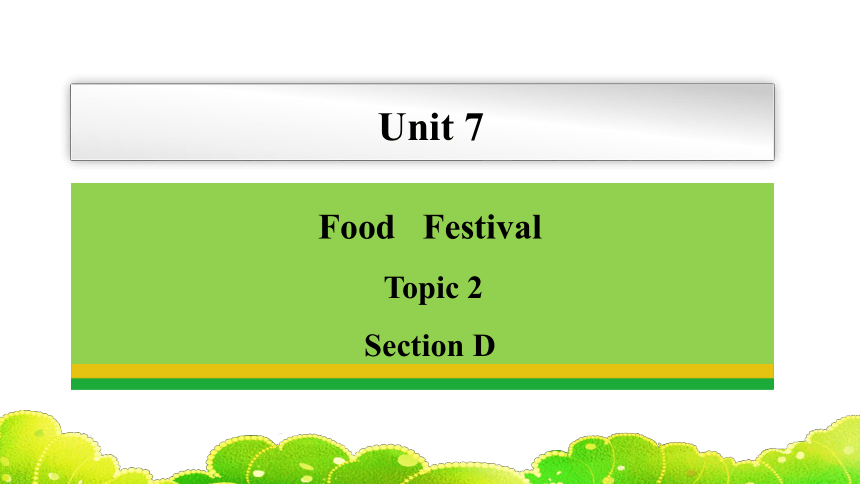 | |
| 格式 | pptx | ||
| 文件大小 | 2.6MB | ||
| 资源类型 | 教案 | ||
| 版本资源 | 仁爱科普版 | ||
| 科目 | 英语 | ||
| 更新时间 | 2024-03-24 21:08:51 | ||
图片预览

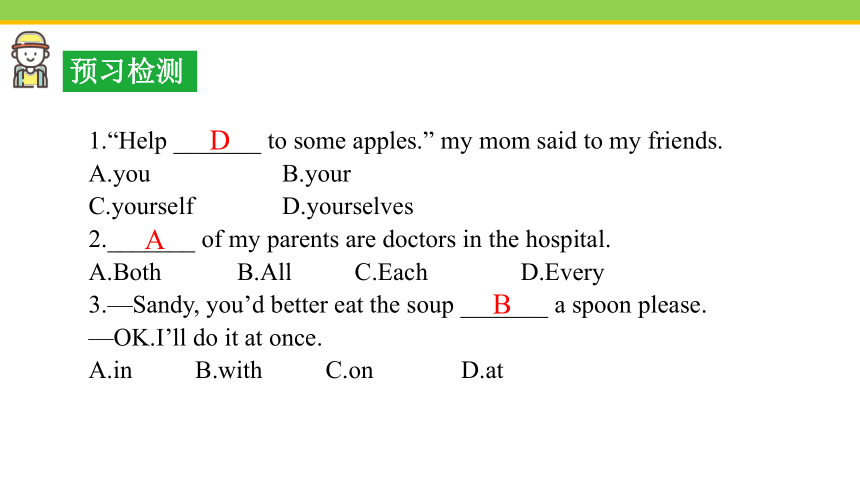
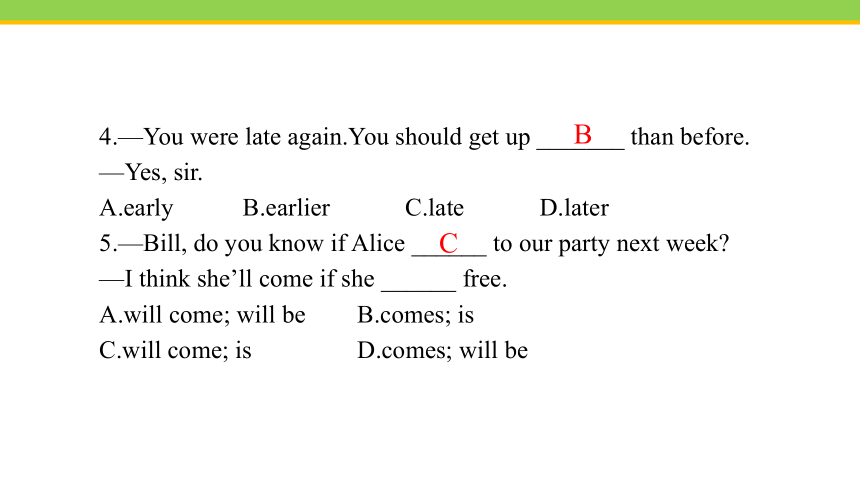

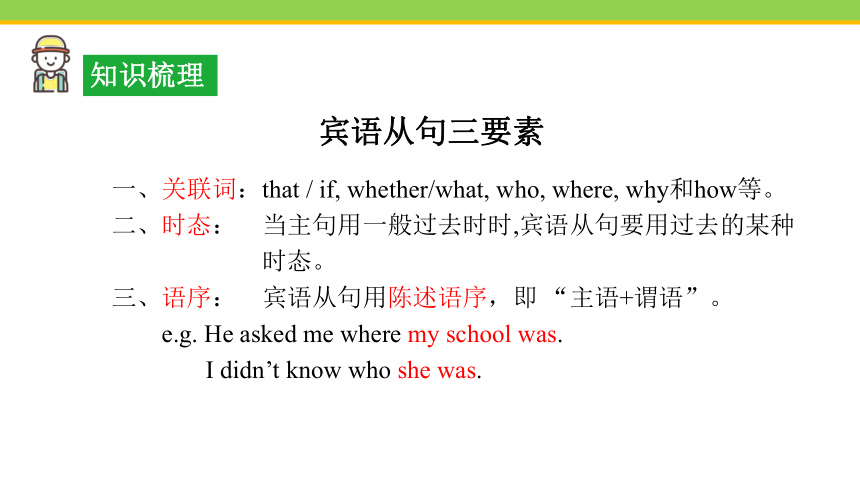



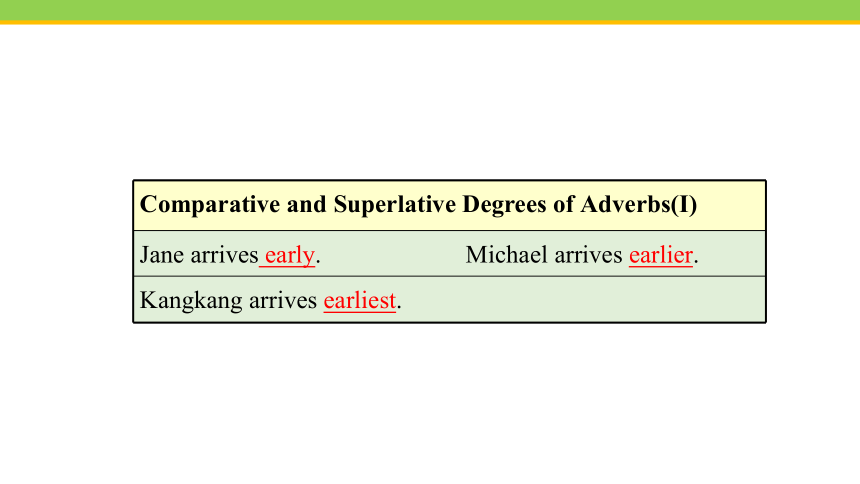
文档简介
(共22张PPT)
Unit 7
Food Festival
Topic 2
Section D
1.“Help _______ to some apples.” my mom said to my friends.
A.you B.your
C.yourself D.yourselves
2._______ of my parents are doctors in the hospital.
A.Both B.All C.Each D.Every
3.—Sandy, you’d better eat the soup _______ a spoon please.
—OK.I’ll do it at once.
A.in B.with C.on D.at
D
A
B
预习检测
4.—You were late again.You should get up _______ than before.
—Yes, sir.
A.early B.earlier C.late D.later
5.—Bill, do you know if Alice ______ to our party next week
—I think she’ll come if she ______ free.
A.will come; will be B.comes; is
C.will come; is D.comes; will be
B
C
能熟悉并掌握本课时的重点单词和短语
1
2
3
能总结 whether/ if 引导的宾语从句的用法
能用英语谈论不同国家的饮食风俗
宾语从句三要素
一、关联词:that / if, whether/what, who, where, why和how等。
二、时态: 当主句用一般过去时时,宾语从句要用过去的某种
时态。
三、语序: 宾语从句用陈述语序,即 “主语+谓语”。
e.g. He asked me where my school was.
I didn’t know who she was.
知识梳理
宾语从句三要素之连接词if/wether
当宾语从句是一般疑问句时,由连词whether或if引导(口语中常用if)
e.g.
I wonder if/whether they’ll have the races again next year.
Ben wonders if/whether April is a good time to visit Thailand.
注:if/whether翻译成:“是否”,具有一定的意义,所以不能省略.
一般情况下,if 和whether可以互换,但以下几种情况只能用whether:
1. 与or not连用;
He asked me whether or not I was coming.
2. 在介词之后;
It depends on whether it is going to rain.
3. 在不定式之前;
We haven’t decided whether to go there.
4. 作主语只能用whether;
Whether he will come is not decided.
只能用whether不用if 的三种情况
不同地区的饮食习惯
重点探究
Object Clauses(Ⅱ)
But I'm not sure whether/if I can cook it well.
Can you tell me if/whether it's polite to eat with your arms or elbows on the table in America
Do you know whether or not it's impolite to smoke during a meal in France
Grammar
Comparative and Superlative Degrees of Adverbs(Ⅰ)
Jane arrives early. Michael arrives earlier.
Kangkang arrives earliest.
First ... Second ... Next ... Then ... After that ... Finally ...
Well done!
Would you mind if we learn to make it from you
Of course not.
Remember not to drink too much.
Functions
People around the world have different eating habits.
in the south of China= in the southern part of China
south n.南方
southern
adj.南方的,南部的
north n.北方
northern adj.北方的
1 Read the passage and underline the different eating tasks in different areas. Then retell the passage and share it with the whole class.
Eating Habits
People around the world have different eating habits.
In North America, Australia and Europe, there are two or more courses for every meal and people use knives and forks to eat.
In the southern part of China, people eat rice a lot, while in the north people often eat noodles. In the central and western parts, people are far away from the sea, so they don’t eat much seafood. But all Chinese people use chopsticks to eat.
In parts of India, people use their fingers to pick up the food.
In Thailand,people eat with a spoon and a fork and they don't use knives at all.
In Korea, people use spoons or chopsticks to eat, but it is not polite to use both of them at the same time.
Country Use …to eat
America knives and forks
Australia
Europe knives and forks
chopsticks
India
a spoon and a fork
Korea
Fill in the blanks according to 1a.
knives and forks
China
fingers
Thailand
spoons or chopsticks
Talk about eating habits in different parts of the world according to 1.
Example:
A: Can you tell me if there are two or more courses for every meal in North America, Australia and Europe
B: Yes, I think so.
A: Do you know if people in the south of China often eat noodles
B: No, I don’t think so. But sometimes they do.
Discussion
2 Suppose you are Beth. Report the following interview notes to your partner.
Beth Tom
Is the most popular food in your restaurant hot dogs Yes, it is.
Are the sausages(香肠) in your hot dogs different from those in others Yes, they are.
Are dumplings your favorite Chinese food No, they aren't.
Do you like Chinese food No, not at all.
Example:
I ask Tom if/whether the most popular food in his restaurant is hot dogs. And he says it is.
I ask Tom if/whether the sausages in your hot dogs are different from those in others. And he says they are.
I ask Tom if/whether dumplings are his favorite Chinese food And he says they aren’t.
I ask Tom if/whether he likes Chinese food. And he says he does not like it at all.
Beth Tom
Are the sausages(香肠) in your hot dogs different from those in others Yes, they are.
Are dumplings your favorite Chinese food No, they aren't.
Do you like Chinese food No, not at all.
3 Look at the pictures and write a passage about how to cook chicken soup.
First, cut up the chicken. Second, wash it. Next, put it into the pot. Then, boil it . After that, add the salt and green onions. Finally, it’s ready and enjoy it.
cut up
wash
put...into
boil
add salt,
green onions
ready, enjoy
Table Manners in Different Countries
Prepare some hats with country names, such as Japan and Cuba on them.
The students wearing the hats will do some eating actions. The other students guess and discuss.
What’s he/she doing
Is it polite to do this during dinner in Japan/Cuba ...
Is it polite to put arms or elbows on the table in Japan/Cuba ...
3. Write a passage about table manners in different countries.
通过以
活动小结
通过以上活动,我们可以知道,不同地区的饮食习惯是1._______,在北美地区,人们通常使用2.____ 和3._____ 等这样的餐具,在4._______ 部分地区, 人们用直接用手吃饭。
不同的
刀
叉
印度
当堂检测
一、用whether/if填空。
1. I asked her __________ she had a bike.
2. We’re worried about ________ he is safe.
3. I don’t know _________ he has recovered or not.
4. He can’t decide _________ to stay.
5. Let me know ________ you can come or not.
6. I wonder _________ I can get some advice from you.
if / whether
whether
whether
whether
whether
whether/if
课堂总结
Unit 7 Topic 2
Section D
重点单词和短语:
southern, seafood, pick, eating habits, in the southern part of, pick up, at the same time
不同地区的饮食习惯:
不同地区的饮食习惯是1._______,在北美地区,人们通常使用2.____ 和3._____ 等这样的餐具,在4._______ 部分地区, 人们用直接用手吃饭。
if/whether引导的宾语从句和表示先后顺序的副词以及副词比较级、最高级:
不同的
刀
叉
印度
Unit 7
Food Festival
Topic 2
Section D
1.“Help _______ to some apples.” my mom said to my friends.
A.you B.your
C.yourself D.yourselves
2._______ of my parents are doctors in the hospital.
A.Both B.All C.Each D.Every
3.—Sandy, you’d better eat the soup _______ a spoon please.
—OK.I’ll do it at once.
A.in B.with C.on D.at
D
A
B
预习检测
4.—You were late again.You should get up _______ than before.
—Yes, sir.
A.early B.earlier C.late D.later
5.—Bill, do you know if Alice ______ to our party next week
—I think she’ll come if she ______ free.
A.will come; will be B.comes; is
C.will come; is D.comes; will be
B
C
能熟悉并掌握本课时的重点单词和短语
1
2
3
能总结 whether/ if 引导的宾语从句的用法
能用英语谈论不同国家的饮食风俗
宾语从句三要素
一、关联词:that / if, whether/what, who, where, why和how等。
二、时态: 当主句用一般过去时时,宾语从句要用过去的某种
时态。
三、语序: 宾语从句用陈述语序,即 “主语+谓语”。
e.g. He asked me where my school was.
I didn’t know who she was.
知识梳理
宾语从句三要素之连接词if/wether
当宾语从句是一般疑问句时,由连词whether或if引导(口语中常用if)
e.g.
I wonder if/whether they’ll have the races again next year.
Ben wonders if/whether April is a good time to visit Thailand.
注:if/whether翻译成:“是否”,具有一定的意义,所以不能省略.
一般情况下,if 和whether可以互换,但以下几种情况只能用whether:
1. 与or not连用;
He asked me whether or not I was coming.
2. 在介词之后;
It depends on whether it is going to rain.
3. 在不定式之前;
We haven’t decided whether to go there.
4. 作主语只能用whether;
Whether he will come is not decided.
只能用whether不用if 的三种情况
不同地区的饮食习惯
重点探究
Object Clauses(Ⅱ)
But I'm not sure whether/if I can cook it well.
Can you tell me if/whether it's polite to eat with your arms or elbows on the table in America
Do you know whether or not it's impolite to smoke during a meal in France
Grammar
Comparative and Superlative Degrees of Adverbs(Ⅰ)
Jane arrives early. Michael arrives earlier.
Kangkang arrives earliest.
First ... Second ... Next ... Then ... After that ... Finally ...
Well done!
Would you mind if we learn to make it from you
Of course not.
Remember not to drink too much.
Functions
People around the world have different eating habits.
in the south of China= in the southern part of China
south n.南方
southern
adj.南方的,南部的
north n.北方
northern adj.北方的
1 Read the passage and underline the different eating tasks in different areas. Then retell the passage and share it with the whole class.
Eating Habits
People around the world have different eating habits.
In North America, Australia and Europe, there are two or more courses for every meal and people use knives and forks to eat.
In the southern part of China, people eat rice a lot, while in the north people often eat noodles. In the central and western parts, people are far away from the sea, so they don’t eat much seafood. But all Chinese people use chopsticks to eat.
In parts of India, people use their fingers to pick up the food.
In Thailand,people eat with a spoon and a fork and they don't use knives at all.
In Korea, people use spoons or chopsticks to eat, but it is not polite to use both of them at the same time.
Country Use …to eat
America knives and forks
Australia
Europe knives and forks
chopsticks
India
a spoon and a fork
Korea
Fill in the blanks according to 1a.
knives and forks
China
fingers
Thailand
spoons or chopsticks
Talk about eating habits in different parts of the world according to 1.
Example:
A: Can you tell me if there are two or more courses for every meal in North America, Australia and Europe
B: Yes, I think so.
A: Do you know if people in the south of China often eat noodles
B: No, I don’t think so. But sometimes they do.
Discussion
2 Suppose you are Beth. Report the following interview notes to your partner.
Beth Tom
Is the most popular food in your restaurant hot dogs Yes, it is.
Are the sausages(香肠) in your hot dogs different from those in others Yes, they are.
Are dumplings your favorite Chinese food No, they aren't.
Do you like Chinese food No, not at all.
Example:
I ask Tom if/whether the most popular food in his restaurant is hot dogs. And he says it is.
I ask Tom if/whether the sausages in your hot dogs are different from those in others. And he says they are.
I ask Tom if/whether dumplings are his favorite Chinese food And he says they aren’t.
I ask Tom if/whether he likes Chinese food. And he says he does not like it at all.
Beth Tom
Are the sausages(香肠) in your hot dogs different from those in others Yes, they are.
Are dumplings your favorite Chinese food No, they aren't.
Do you like Chinese food No, not at all.
3 Look at the pictures and write a passage about how to cook chicken soup.
First, cut up the chicken. Second, wash it. Next, put it into the pot. Then, boil it . After that, add the salt and green onions. Finally, it’s ready and enjoy it.
cut up
wash
put...into
boil
add salt,
green onions
ready, enjoy
Table Manners in Different Countries
Prepare some hats with country names, such as Japan and Cuba on them.
The students wearing the hats will do some eating actions. The other students guess and discuss.
What’s he/she doing
Is it polite to do this during dinner in Japan/Cuba ...
Is it polite to put arms or elbows on the table in Japan/Cuba ...
3. Write a passage about table manners in different countries.
通过以
活动小结
通过以上活动,我们可以知道,不同地区的饮食习惯是1._______,在北美地区,人们通常使用2.____ 和3._____ 等这样的餐具,在4._______ 部分地区, 人们用直接用手吃饭。
不同的
刀
叉
印度
当堂检测
一、用whether/if填空。
1. I asked her __________ she had a bike.
2. We’re worried about ________ he is safe.
3. I don’t know _________ he has recovered or not.
4. He can’t decide _________ to stay.
5. Let me know ________ you can come or not.
6. I wonder _________ I can get some advice from you.
if / whether
whether
whether
whether
whether
whether/if
课堂总结
Unit 7 Topic 2
Section D
重点单词和短语:
southern, seafood, pick, eating habits, in the southern part of, pick up, at the same time
不同地区的饮食习惯:
不同地区的饮食习惯是1._______,在北美地区,人们通常使用2.____ 和3._____ 等这样的餐具,在4._______ 部分地区, 人们用直接用手吃饭。
if/whether引导的宾语从句和表示先后顺序的副词以及副词比较级、最高级:
不同的
刀
叉
印度
同课章节目录
- Unit 5 Feeling excited
- Topic 1 You look excited
- Topic 2 I’m feeling better now.
- Topic 3 Many things can affect our feelings.
- Unit 6 Enjoying Cycling
- Topic 1 We're going on a three-day visit to Mount
- Topic 2 How about exploring Tian’anmen Square?
- Topic 3 Bicycle riding is good exercise.
- Unit 7 Food festival
- Topic 1 We’re preparing for a food festival.
- Topic 2 I’m not sure whether I can cook it well.
- Topic 3 I Cooked the Most Successfully
- Unit 8 Our Clothes
- Topic 1 We will have a class fashion show.
- Topic 2 We can design our own uniforms.
- Topic 3 He said the fashion show was wonderful.
